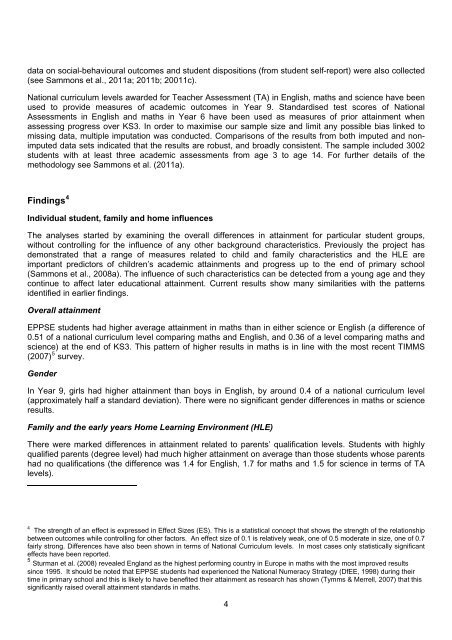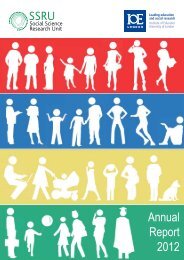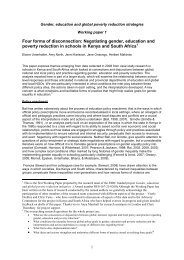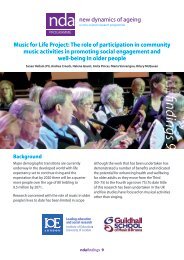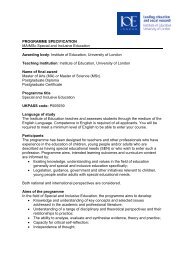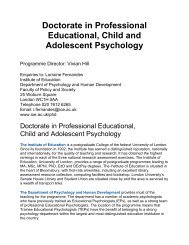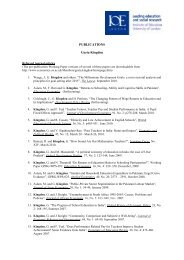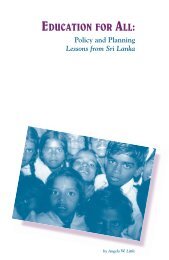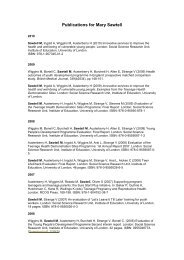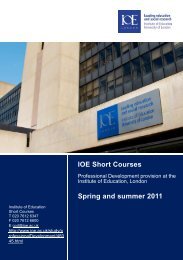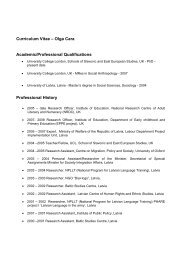Influences on students' attainment - Institute of Education, University ...
Influences on students' attainment - Institute of Education, University ...
Influences on students' attainment - Institute of Education, University ...
Create successful ePaper yourself
Turn your PDF publications into a flip-book with our unique Google optimized e-Paper software.
data <strong>on</strong> social-behavioural outcomes and student dispositi<strong>on</strong>s (from student self-report) were also collected<br />
(see Samm<strong>on</strong>s et al., 2011a; 2011b; 20011c).<br />
Nati<strong>on</strong>al curriculum levels awarded for Teacher Assessment (TA) in English, maths and science have been<br />
used to provide measures <strong>of</strong> academic outcomes in Year 9. Standardised test scores <strong>of</strong> Nati<strong>on</strong>al<br />
Assessments in English and maths in Year 6 have been used as measures <strong>of</strong> prior <strong>attainment</strong> when<br />
assessing progress over KS3. In order to maximise our sample size and limit any possible bias linked to<br />
missing data, multiple imputati<strong>on</strong> was c<strong>on</strong>ducted. Comparis<strong>on</strong>s <strong>of</strong> the results from both imputed and n<strong>on</strong>imputed<br />
data sets indicated that the results are robust, and broadly c<strong>on</strong>sistent. The sample included 3002<br />
students with at least three academic assessments from age 3 to age 14. For further details <strong>of</strong> the<br />
methodology see Samm<strong>on</strong>s et al. (2011a).<br />
Findings 4<br />
Individual student, family and home influences<br />
The analyses started by examining the overall differences in <strong>attainment</strong> for particular student groups,<br />
without c<strong>on</strong>trolling for the influence <strong>of</strong> any other background characteristics. Previously the project has<br />
dem<strong>on</strong>strated that a range <strong>of</strong> measures related to child and family characteristics and the HLE are<br />
important predictors <strong>of</strong> children’s academic <strong>attainment</strong>s and progress up to the end <strong>of</strong> primary school<br />
(Samm<strong>on</strong>s et al., 2008a). The influence <strong>of</strong> such characteristics can be detected from a young age and they<br />
c<strong>on</strong>tinue to affect later educati<strong>on</strong>al <strong>attainment</strong>. Current results show many similarities with the patterns<br />
identified in earlier findings.<br />
Overall <strong>attainment</strong><br />
EPPSE students had higher average <strong>attainment</strong> in maths than in either science or English (a difference <strong>of</strong><br />
0.51 <strong>of</strong> a nati<strong>on</strong>al curriculum level comparing maths and English, and 0.36 <strong>of</strong> a level comparing maths and<br />
science) at the end <strong>of</strong> KS3. This pattern <strong>of</strong> higher results in maths is in line with the most recent TIMMS<br />
(2007) 5 survey.<br />
Gender<br />
In Year 9, girls had higher <strong>attainment</strong> than boys in English, by around 0.4 <strong>of</strong> a nati<strong>on</strong>al curriculum level<br />
(approximately half a standard deviati<strong>on</strong>). There were no significant gender differences in maths or science<br />
results.<br />
Family and the early years Home Learning Envir<strong>on</strong>ment (HLE)<br />
There were marked differences in <strong>attainment</strong> related to parents’ qualificati<strong>on</strong> levels. Students with highly<br />
qualified parents (degree level) had much higher <strong>attainment</strong> <strong>on</strong> average than those students whose parents<br />
had no qualificati<strong>on</strong>s (the difference was 1.4 for English, 1.7 for maths and 1.5 for science in terms <strong>of</strong> TA<br />
levels).<br />
4 The strength <strong>of</strong> an effect is expressed in Effect Sizes (ES). This is a statistical c<strong>on</strong>cept that shows the strength <strong>of</strong> the relati<strong>on</strong>ship<br />
between outcomes while c<strong>on</strong>trolling for other factors. An effect size <strong>of</strong> 0.1 is relatively weak, <strong>on</strong>e <strong>of</strong> 0.5 moderate in size, <strong>on</strong>e <strong>of</strong> 0.7<br />
fairly str<strong>on</strong>g. Differences have also been shown in terms <strong>of</strong> Nati<strong>on</strong>al Curriculum levels. In most cases <strong>on</strong>ly statistically significant<br />
effects have been reported.<br />
5 Sturman et al. (2008) revealed England as the highest performing country in Europe in maths with the most improved results<br />
since 1995. It should be noted that EPPSE students had experienced the Nati<strong>on</strong>al Numeracy Strategy (DfEE, 1998) during their<br />
time in primary school and this is likely to have benefited their <strong>attainment</strong> as research has shown (Tymms & Merrell, 2007) that this<br />
significantly raised overall <strong>attainment</strong> standards in maths.<br />
4


